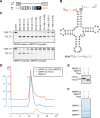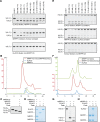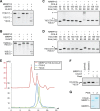The MRPP1/MRPP2 complex is a tRNA-maturation platform in human mitochondria
- PMID: 29040705
- PMCID: PMC5716156
- DOI: 10.1093/nar/gkx902
The MRPP1/MRPP2 complex is a tRNA-maturation platform in human mitochondria
Abstract
Mitochondrial polycistronic transcripts are extensively processed to give rise to functional mRNAs, rRNAs and tRNAs; starting with the release of tRNA elements through 5'-processing by RNase P (MRPP1/2/3-complex) and 3'-processing by RNase Z (ELAC2). Here, we show using in vitro experiments that MRPP1/2 is not only a component of the mitochondrial RNase P but that it retains the tRNA product from the 5'-processing step and significantly enhances the efficiency of ELAC2-catalyzed 3'-processing for 17 of the 22 tRNAs encoded in the human mitochondrial genome. Furthermore, MRPP1/2 retains the tRNA product after ELAC2 processing and presents the nascent tRNA to the mitochondrial CCA-adding enzyme. Thus, in addition to being an essential component of the RNase P reaction, MRPP1/2 serves as a processing platform for several down-stream tRNA maturation steps in human mitochondria. These findings are of fundamental importance for our molecular understanding of disease-related mutations in MRPP1/2, ELAC2 and mitochondrial tRNA genes.
© The Author(s) 2017. Published by Oxford University Press on behalf of Nucleic Acids Research.
Figures





Similar articles
-
Structural insight into the human mitochondrial tRNA purine N1-methyltransferase and ribonuclease P complexes.J Biol Chem. 2018 Aug 17;293(33):12862-12876. doi: 10.1074/jbc.RA117.001286. Epub 2018 Jun 7. J Biol Chem. 2018. PMID: 29880640 Free PMC article.
-
Involvement of human ELAC2 gene product in 3' end processing of mitochondrial tRNAs.RNA Biol. 2011 Jul-Aug;8(4):616-26. doi: 10.4161/rna.8.4.15393. Epub 2011 Jul 1. RNA Biol. 2011. PMID: 21593607
-
RNA processing in human mitochondria.Cell Cycle. 2011 Sep 1;10(17):2904-16. doi: 10.4161/cc.10.17.17060. Epub 2011 Sep 1. Cell Cycle. 2011. PMID: 21857155
-
Advances in Human Pre-tRNA Maturation: TRMT10C and ELAC2 in Focus.J Mol Biol. 2025 Aug 15;437(16):168989. doi: 10.1016/j.jmb.2025.168989. Epub 2025 Feb 10. J Mol Biol. 2025. PMID: 39938738 Review.
-
Of P and Z: mitochondrial tRNA processing enzymes.Biochim Biophys Acta. 2012 Sep-Oct;1819(9-10):1017-26. doi: 10.1016/j.bbagrm.2011.11.003. Epub 2011 Nov 23. Biochim Biophys Acta. 2012. PMID: 22137969 Free PMC article. Review.
Cited by
-
TRMT10C gene polymorphisms confer hepatoblastoma susceptibility: evidence from a seven-center case-control study.J Cancer. 2024 Aug 19;15(16):5396-5402. doi: 10.7150/jca.98555. eCollection 2024. J Cancer. 2024. PMID: 39247598 Free PMC article.
-
Mitochondrion-targeted RNA therapies as a potential treatment strategy for mitochondrial diseases.Mol Ther Nucleic Acids. 2022 Oct 27;30:359-377. doi: 10.1016/j.omtn.2022.10.012. eCollection 2022 Dec 13. Mol Ther Nucleic Acids. 2022. PMID: 36420220 Free PMC article. Review.
-
Substrate Profiling of Mitochondrial Caseinolytic Protease P via a Site-Specific Photocrosslinking Approach.Angew Chem Int Ed Engl. 2022 Mar 1;61(10):e202111085. doi: 10.1002/anie.202111085. Epub 2022 Jan 14. Angew Chem Int Ed Engl. 2022. PMID: 34847623 Free PMC article.
-
Cleavage kinetics of human mitochondrial RNase P and contribution of its non-nuclease subunits.Nucleic Acids Res. 2023 Oct 27;51(19):10536-10550. doi: 10.1093/nar/gkad713. Nucleic Acids Res. 2023. PMID: 37779095 Free PMC article.
-
RNA degradation in human mitochondria: the journey is not finished.Hum Mol Genet. 2024 May 22;33(R1):R26-R33. doi: 10.1093/hmg/ddae043. Hum Mol Genet. 2024. PMID: 38779774 Free PMC article. Review.
References
-
- Hällberg B.M., Larsson N.G.. Making proteins in the powerhouse. Cell Metab. 2014; 20:226–240. - PubMed
-
- Kauppila T.E., Kauppila J.H., Larsson N.G.. Mammalian mitochondria and aging: an update. Cell Metab. 2017; 25:57–71. - PubMed
-
- Anderson S., Bankier A.T., Barrell B.G., de Bruijn M.H., Coulson A.R., Drouin J., Eperon I.C., Nierlich D.P., Roe B.A., Sanger F. et al. . Sequence and organization of the human mitochondrial genome. Nature. 1981; 290:457–465. - PubMed
MeSH terms
Substances
LinkOut - more resources
Full Text Sources
Other Literature Sources
Molecular Biology Databases
Miscellaneous

